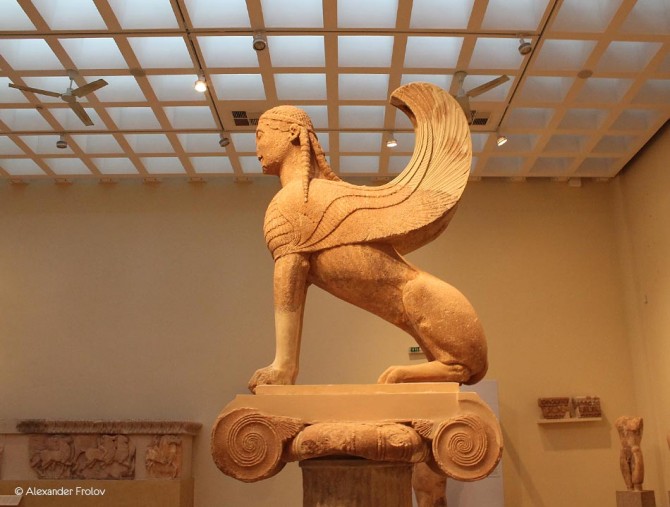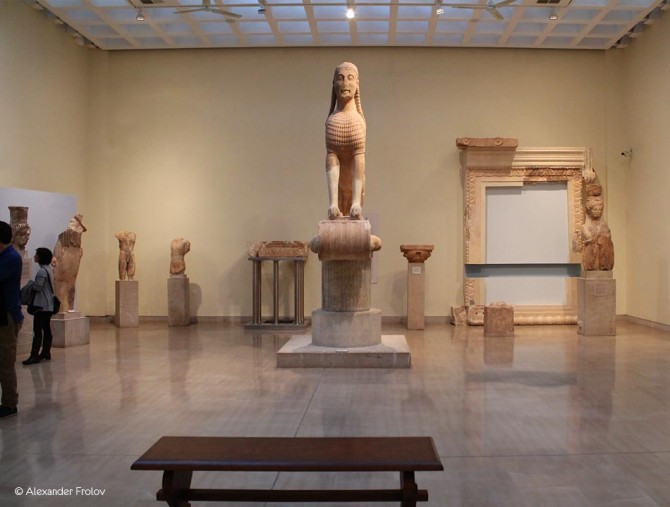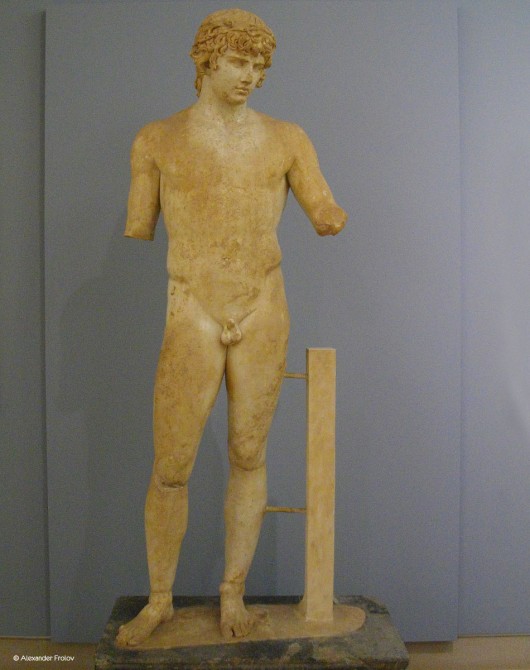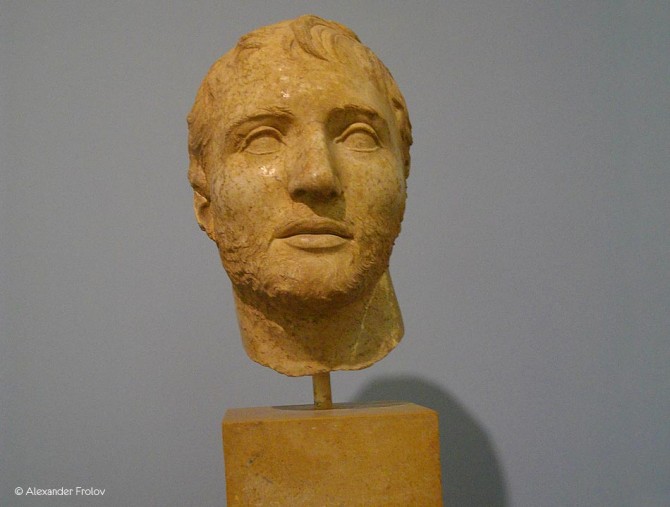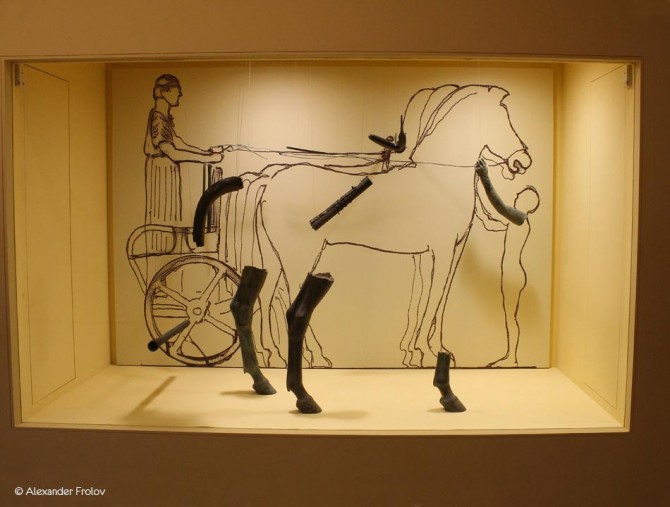Археологический музей в Делфах
Когда-то Дельфы были важнейшим городов Греческого мира, а Дельфийский оракул - наиболее уважаемым оракулом на протяжении многих веков. В наши дни все наиболее важные и ценные находки Дельфов, уцелевшие во время многочисленных грабежей и стихийных бедствий, можно увидеть в местном археологическом музее. Музей этот считается одним из самых богатых в Греции - тут экспонируется более 6 тысяч предметов.
Большинство из них - это “подношения” Апполону. В древние времена за предсказанием к оракулу отправлялись не спустыми руками. Эти впечатляющие экспонаты, представляющие временной отрезок начиная с времен архаики и заканчивая эпохой Древнего Рима, тут выставлены в хронологической последовательности. Таким образом можно проследить эволюцию и угасание этого великого города.
В первых двух залах мы видим артефакты эпохи “до культа Апполона”. Третий зал посвящен раннеархаическому времени, тут находится знаменитые статуи Близнецов. Существует две версии идентификации статуй. Первая – близнецы могли быть братьями Клеобис и Битон из Аргоса. А статуи, выполненные в их честь, преподнесены дельфийскому храму местными жителями Аргоса. Вторая версия - братья Кастор и Поллукс (именуемые диоскурами, то есть ´сыновья Зевсаª), культ которых был широко распространен на Пелопонессе. Архитектором этих двух мужских статуй был греческий Полимедес, выходец из Аргоса.
В четвертом зале представлены изделия из золота и слоновой кости - те самые подношения, предположительно из городов восточной Греции. В зале номер 5 можно увидеть фрагменты сокровищницы Сифнеи. Среди них - статуя Сфинкса Наксии. Следующий зал полностью посвящен Храму Апполона - тут представлены некоторые украшающих храм фрагментов скульптурных композиций. В залах 6-8 можно любоваться скульптурным оформлением Храма Афинян. Это единственный храм в Дельфах, который был полностью восстановлен. А построен он был афинянами в честь победы над персами. В нем находились подношения Апполону. В девятом зале представлены две находки из святилища Афины Пронаи и три статуэтки из бронзы. В следующем зале можно увидеть купол кругового здания Святилища Афины Пронаи.
Статуя ”Дельфийский возничий”, ценнейший экспонат музея, созданный примерно в 478 году до нашей эры - главный экспонат следующего зала. Тут же можно видеть скульптуру под названием “Три танцующие девушки”, которая, как считают некоторые специалисты, могла служить в качестве опоры для треножника, где восседала жрица по имени Пифия. Далее идет коллекция статуй римской эпохи. В двенадцатом зале находятся сокровища из Храма Афины Пронаи, в том числе впечатляющее изделия из металла римской эпохи. Артефакты из тринадцатого зала уцелели (странно сказать) благодаря сильнейшему землетрясению 373 года до нашей эры. Тогда эти сокровища были погребены под обломками, и соответственно, не были разграблены. Знакомство с Дельфийским Оракулом заканчивается в четырнадцатом зале, где представлены портреты римских императоров, а также артефактами христианской эпохи.
Археологический музей в Дельфах
Префектура Фокида, центральная Греция
Часы работы: 8:00-15:00 ежедневно
Цена билета: 6 евро, 3 евро льготный. Единый входной билет по которому можно посетить раскопки и музей стоит 9 евро. Каждое первое воскресенье зимой - вход свободный.
Как добраться до археологического музея в Дельфах:
- на машине из Афин (178 км) по национальной трассе Ε75/Α1, далее по трассе Ливадия-Амфиса ΕΟ48
- на машине из Салоников (380 км) по трассе E75
- на автобусе из Афин с автовокзала Лиссион (260 Liossion Avenue) до города Дельфы,
автовокзал в Дельфах: ул. Фраггу 14, тел. 210 22650 82317
Из Дельфов до археологических раскопок на такси (2 км)
Фото и текст: Александр Фролов
The Archaeological Museum of Delphi
The grandeur and the wealth of the famous Oracle of Delphi is presented piece by piece in the homonymous archaeological museum, which is one of the most important of Greece. The unique finds from the excavations, that survived looting and natural disasters over the centuries, reveal the story of the sanctuary and the oracle that defined the life of the ancient world, including objects which chronologically cover many centuries, from prehistory to late antiquity. Most of them are offerings to the sanctuary of Apollo, dating back to the heyday, from the Archaic to the Roman era. The impressive exhibits are grouped and integrated into broader exhibition sections, so that the visitor can understand the periods of prosperity or bending of the sanctuary, the financial soundness of the dedicators, the identity of the artistic laboratories which undertook the production of the offerings, and also the housing and the population growth around the sanctuary.
Starting our tour at the museum, from the Halls I and II, we do a flash back in the early years of the sanctuary, before the cult of Apollo, and the transition to the new era and the new cult. The Hall III of the Early Archaic period is dominated by the impressive pair of lifesize Archaic Greek statues, the Twins of Argos. The Hall IV presents the precious, gold and ivory offerings from the cities of eastern Greece, while the Hall V houses parts of the luxurious Siphnian Treasury (among them, there is the Naxian Sphinx). The imposing temple of Apollo is the theme of the Hall VI, including architectural elements and the pedimental compositions of the archaic and classical temple. Moving to the Halls VI and VIII, we can admire the sculptural decoration of the Athenian Treasure, the only building of the archaeological site of Delphi which is completely restored. The sculptural and written clay decoration of the two treasuries of the sanctuary of Athena
Pronaia, three bronze statuettes-offerings, the Piper and the Cluster of the Two Athletes are among the exhibits of the Hall IX, all dated in the 5th Century BD. The Hall X presents the Dome, the circular building of the sanctuary of Athena Pronaia. In the Hall XI of the late Classical-Hellenistic times, you will be impressed by the Cluster of Daochos, the Navel, which was the symbol of the Delphic Oracle, and the Spiny Column with the Dancers. In the Hall XII, the Frieze of the impressive offering of Aemilius Paulus launches the series of the monuments of the Roman history in the sanctuary –among them there are the Circular Aaltar of Athena Pronaia, the Antinoos, the portrait of Flamininus and representative Roman metalwork. One of the most important exhibits of the museum and one of the most famous ancient statues in the world is the Complex of the Charioteer, in the Hall XIII, which is preserved thanks to a great earthquake in 373 BC, which buried
it under the ruins, “protecting” it by the looting and other natural disasters. The tour to the amazing past of the Oracle of Delphi ends at the Hall XIV, with the inscriptions and the portraits of the era of the Roman emperors, as well as architectural parts and lamps with Christian symbols that illustrate the transition to the new religion.
The Archaeological Museum of Delphi, Delphi, prefecture of Phocis, Central Greece. Visiting hours: Daily, 8:00-15:00 (last entrance 14:30). Ticket prices: (Full) 6 euros, (Ruduced) 3 euros. Unified ticket: (Full) 9 euros, (Reduced) 5 euros (valid for the Archaeological site of Delphi and the Archaeological Museum of Delphi).
How to get there: By car from Athens (distance 178 km) via Α/Δ ΠΑΘΕ/E75/Α1 and National Road Livadeia-Amfissa/ΕΟ48, from Thessaloniki (distance 380 km) via E75. By bus from Athens to the city of Delphi: Athens Bus Station (260 Liossion Avenue, Athens) tel.: +30 210 83 17 096, Delphi Bus Station (14 D. Fraggou St., Delphi) tel.: 210 22650 82317. From Delphi you can go by taxi to the archaeological museum (distance 2 km).
Τext: Marilou Pantazi
The grandeur and the wealth of the famous Oracle of Delphi is presented piece by piece in the homonymous archaeological museum, which is one of the most important of Greece. The unique finds from the excavations, that survived looting and natural disasters over the centuries, reveal the story of the sanctuary and the oracle that defined the life of the ancient world, including objects which chronologically cover many centuries, from prehistory to late antiquity. Most of them are offerings to the sanctuary of Apollo, dating back to the heyday, from the Archaic to the Roman era. The impressive exhibits are grouped and integrated into broader exhibition sections, so that the visitor can understand the periods of prosperity or bending of the sanctuary, the financial soundness of the dedicators, the identity of the artistic laboratories which undertook the production of the offerings, and also the housing and the population growth around the sanctuary.
Starting our tour at the museum, from the Halls I and II, we do a flash back in the early years of the sanctuary, before the cult of Apollo, and the transition to the new era and the new cult. The Hall III of the Early Archaic period is dominated by the impressive pair of lifesize Archaic Greek statues, the Twins of Argos. The Hall IV presents the precious, gold and ivory offerings from the cities of eastern Greece, while the Hall V houses parts of the luxurious Siphnian Treasury (among them, there is the Naxian Sphinx). The imposing temple of Apollo is the theme of the Hall VI, including architectural elements and the pedimental compositions of the archaic and classical temple. Moving to the Halls VI and VIII, we can admire the sculptural decoration of the Athenian Treasure, the only building of the archaeological site of Delphi which is completely restored. The sculptural and written clay decoration of the two treasuries of the sanctuary of Athena
Pronaia, three bronze statuettes-offerings, the Piper and the Cluster of the Two Athletes are among the exhibits of the Hall IX, all dated in the 5th Century BD. The Hall X presents the Dome, the circular building of the sanctuary of Athena Pronaia. In the Hall XI of the late Classical-Hellenistic times, you will be impressed by the Cluster of Daochos, the Navel, which was the symbol of the Delphic Oracle, and the Spiny Column with the Dancers. In the Hall XII, the Frieze of the impressive offering of Aemilius Paulus launches the series of the monuments of the Roman history in the sanctuary –among them there are the Circular Aaltar of Athena Pronaia, the Antinoos, the portrait of Flamininus and representative Roman metalwork. One of the most important exhibits of the museum and one of the most famous ancient statues in the world is the Complex of the Charioteer, in the Hall XIII, which is preserved thanks to a great earthquake in 373 BC, which buried
it under the ruins, “protecting” it by the looting and other natural disasters. The tour to the amazing past of the Oracle of Delphi ends at the Hall XIV, with the inscriptions and the portraits of the era of the Roman emperors, as well as architectural parts and lamps with Christian symbols that illustrate the transition to the new religion.
The Archaeological Museum of Delphi, Delphi, prefecture of Phocis, Central Greece. Visiting hours: Daily, 8:00-15:00 (last entrance 14:30). Ticket prices: (Full) 6 euros, (Ruduced) 3 euros. Unified ticket: (Full) 9 euros, (Reduced) 5 euros (valid for the Archaeological site of Delphi and the Archaeological Museum of Delphi).
How to get there: By car from Athens (distance 178 km) via Α/Δ ΠΑΘΕ/E75/Α1 and National Road Livadeia-Amfissa/ΕΟ48, from Thessaloniki (distance 380 km) via E75. By bus from Athens to the city of Delphi: Athens Bus Station (260 Liossion Avenue, Athens) tel.: +30 210 83 17 096, Delphi Bus Station (14 D. Fraggou St., Delphi) tel.: 210 22650 82317. From Delphi you can go by taxi to the archaeological museum (distance 2 km).
Τext: Marilou Pantazi


